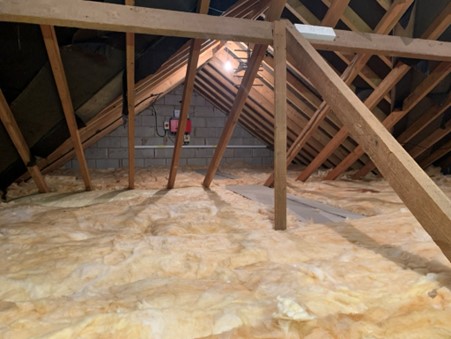We reported that our home, the Old Post Office Kempley Green, Kempley, Gloucestershire (within the Forest of Dean AURORA Demonstration Pilot Area) became fossil fuel free in December 2022 with the installation of air source heat pumps. This has been part of a long journey to achieve that goal. Two months on how are we faring, and what are the lessons learned from the final stage in installing air source heat pumps.
Over the two-month period, we had two major cold periods with temperatures dropping to below -5C at night. The first cold snap occurred whilst was still commissioning the unit and before we had installed extra insulation in our loft. By this time we had decommissioned our gas boiler and were reliant on the air source heat pump and a wood burner for heat. The second cold snap has just occurred and is post installation of the additional insulation.
Heat pumps work in a different way to a gas boiler, gradually building up heat in the home and relying on insulation to maintain heat levels. During the first cold period, our insulation just was not good enough and without the log burner (which is centrally located in the home) we would have struggled to maintain effective temperatures. As it was the electricity cost to run the system was substantial and coincided with increases in electricity costs within the UK. Not the best timing and a real lesson in the need to get maximum insulation in place before installing the heat pumps.
The second cold period is different and we can now maintain temperatures at acceptable levels, but to keep costs down we still use the log burner on a continuous basis. With the two systems working in tandem, we can maintain effective temperatures in the main living spaces and accept lower temperatures elsewhere in the house. We are closely monitoring running costs to see how our overall heating bills compare to the previous systems. The UK has one of the highest electricity costs in Europe and the price of electricity has no relationship to the source of the energy we are using. In our case, we are using 100% renewable energy, but are forced to pay a price that reflects global gas prices. This is a ridiculous situation and is a hidden subsidy to the fossil fuel industry. THIS MUST CHANGE

We have also taken the decision not to upgrade radiators to keep capital costs down and recognise that the Air Source heat pump is operating at a sub-optimal level. Our intention was always to operate the Air Source Heat pump to raise background heat levels in the property and to use the wood burner to lift temperatures in the key living spaces. As we live in a rural wooded area dry logs are easily available and air pollution levels are very low. Larger radiators will have to wait till further funds can be found.
The lesson is clear, complete all insulation upgrades before installing heat pumps and if you want to get the full benefits from the switch from gas boilers upgrade your radiators unless you have an alternate point source heat system.
With respect to hot water, the Air Source heat pump system has worked efficiently and delivers all the hot water we can use. The new gravity-fed shower has been installed and works perfectly and we no longer need power showers.
Recent articles in the Financial Times highlight that UK consumers are hesitating to install heat pumps and that only 8,771 vouchers for grants of £5,000 – £6,000 have been issued to homeowners to reduce the cost of installing Air Source Heat Pumps. This means less than 0.013% of the population is accessing these grants. The same article highlights how critical it is to reduce carbon emissions from residential properties in the UK as they account for about a fifth of the UK’s total emissions. Citizens’ decisions are therefore critical if the UK is to reach the “net zero” emissions target by 2050.
Surveys by Samsung and Centrica identify a number of barriers to the use of heat pumps including:
- Upfront costs;
- Disruption during installation
- Lack of skilled contractors to design and install the systems.
A report by NESTA in the UK estimates that only 3000 heat pump engineers are fully trained and that the UK will need 27,000 to deliver the targets Governments say they want to achieve.
I would also add that “early stories” about poorly installed Air Source Heat pumps in buildings with inadequate insulation and poorly sized radiators are adding to concerns about what is a major and radical shift in the way we heat our homes.
Let me know on the AURORA Twitter feed if these problems affect you across Europe or if the UK is once again the laggard in moving away from fossil fuels. Also share your experience in switching to Air Source Heat Pumps. We all need to know how to avoid the pitfalls and encourage others to make the change.
Martin Brocklehurst



